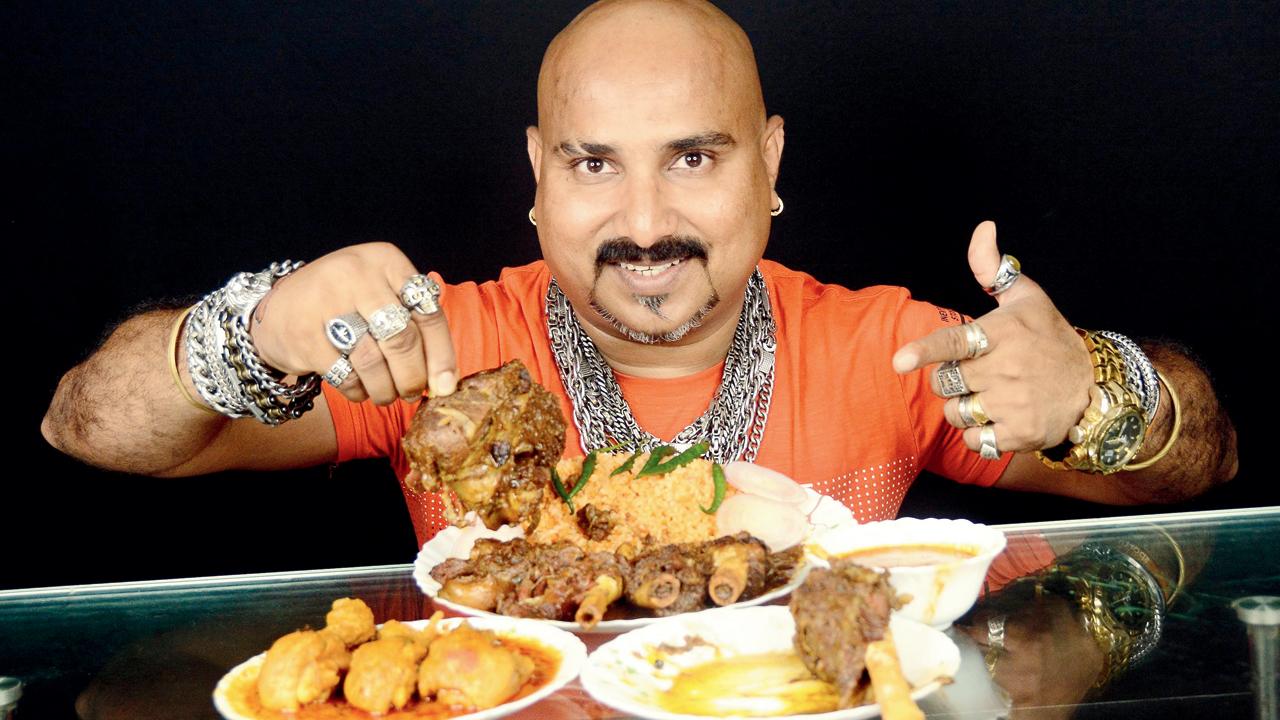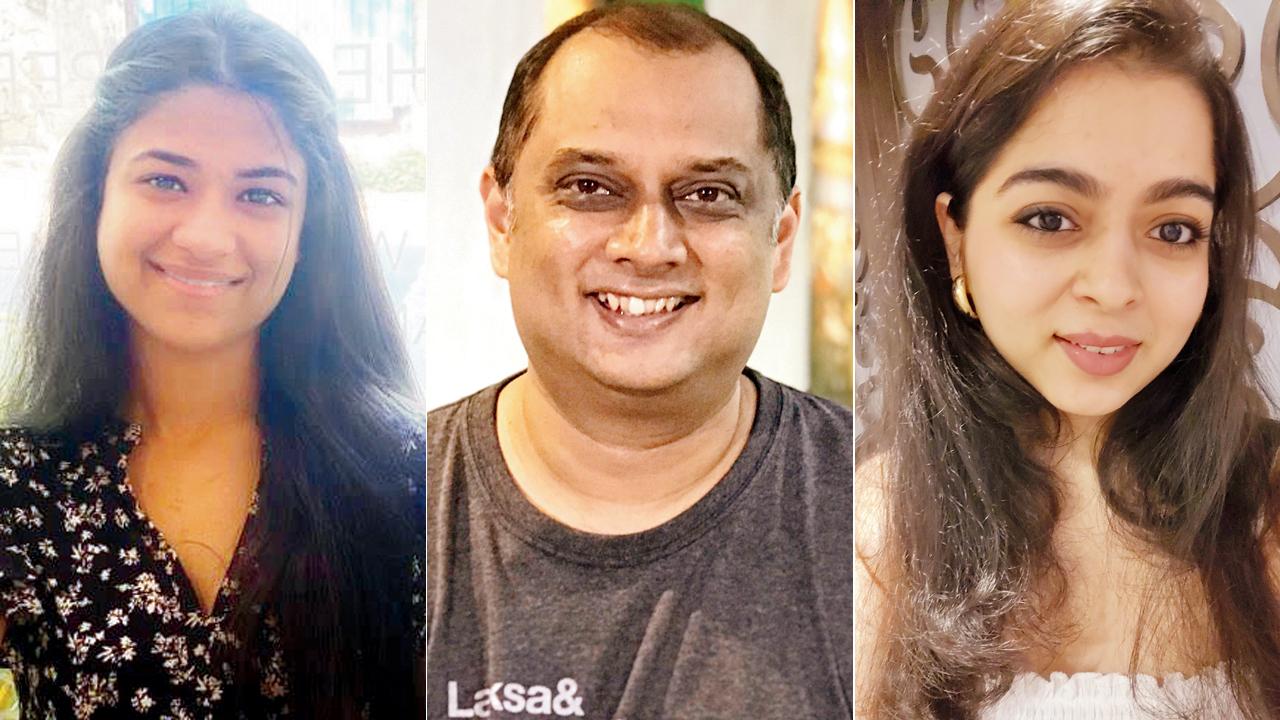A crazy Korean video trend has caught on among isolated foodies during the pandemic for its unmatched sensory high, leaving health experts warning both influencer and audience of the secret dangers of force eating

Ghatkopar resident Ulhas Kamathe, popularly known as Chicken Leg Piece Guy, is a Mukbang influencer who makes videos of gorging on tangdi kebab, chicken biryani and sukha bombil. Pic/Sayyed Sameer Abedi
Forty-two-year-old Ghatkopar resident Ulhas Kamathe, better known as the Chicken Leg Piece guy, started making lipsyncing videos on TikTok until a spontaneous food video went viral internationally. Not a follower of international mukbang videos, Kamathe poured his own unique style into his content—with his signature act of holding a leg of chicken, saying the words “chicken leg piece” out loud and then promptly gorging on it—and found them drawing millions to his channel. A staunch non-vegetarian, Kamathe shares that he has always preferred variety in his meals and has had a predilection for spicy food. But when not promoting a restaurant, does he cook the variety of items that feature in his videos? “I can’t cook at all. I can only eat!” laughs Kamathe, admitting that his wife Archana has catered to his gastronomic demands for years given his general reluctance to order restaurant dishes. Expectedly, plump legs of chicken are a favourite, followed by chicken biriyani and dried Bombay duck or sukha bombil.
Dehradun-based creator Akshanshu Aswal, 26, however, unlike Kamathe, has followed TV shows like James Cunningham’s Eat St. about North American street food and Adam Richman’s highly indulgent Man v. Food for years, eager to start his own YouTube channel on travelling and food. As a cinematographer who worked in Mumbai for two years prior to his video creator stint, a love of filmmaking further helped bring these varied interests together. With travel restricted in early 2020, he decided to give mukbang videos a try, admitting to having little prior knowledge of them.
ADVERTISEMENT
 Dehradun-based Akshanshu Aswal, 26, is a mukbang video creator, who used his filmmaking experience in the lockdown to get creative without having to step out
Dehradun-based Akshanshu Aswal, 26, is a mukbang video creator, who used his filmmaking experience in the lockdown to get creative without having to step out
This kind of food content can be roughly divided into two types, explains Aswal. While mukbang videos typically have hosts consuming food while interacting with their audience, there are ASMR (Autonomous sensory meridian response) videos which accentuate sounds of eating like a crunch or a slurp, which apparently audiences find soothing. Moreover, the original target audience for these videos which first surfaced in South Korea over a decade ago were people living solitary lives, like students pursuing academics away from their homes. “They were for people who were living, eating and preparing their food alone,” says Aswal.
Apart from an easy interactive style and a practice of featuring Japanese and American cuisines and comparing them to traditional Indian foods that have proved popular with viewers, what has stoked viewer curiosity and interest, believes Aswal, is the fact that he has been able to maintain his health and abs despite the regular binge sessions. Believing in maintaining a balance, and with proper consultation with dieticians, he combines gym and home workout sessions with omad (one meal a day) diets where the food he consumes for online is his only meal of the day, proceeding to starve himself for the next 48-72 hours if those meals prove particularly heavy.
 Mumbai resident Ulhas Kamathe says he has always been a fan of spicy food and in fact, adds extra chillies to his plate if his meal doesn’t have the required heat. Pic/Sayyed Sameer Abedi
Mumbai resident Ulhas Kamathe says he has always been a fan of spicy food and in fact, adds extra chillies to his plate if his meal doesn’t have the required heat. Pic/Sayyed Sameer Abedi
Aswal, whose YouTube channel has around 4,13,000 subscribers, however, knows that there’s something more that does the trick. “I imagine myself as my audience. I would love to watch someone eat things that I can’t eat, and that’s why I upload my videos at night [when people are generally eating their meals],” he says. For 19-year-old Gia Badami who follows international creators like Eloise Head and Nic Kaufmann on Instagram, the sight of scrumptious junk food like ramen, burgers and pizzas induces hunger. “When I see so much of good food on screen and then look down to see dal chawal on my plate, it somehow makes the latter less boring,” sharing that the videos have both an entertaining and a deliciously soothing quality.
It is this addictive nature of the videos, associated with a steady surge of dopamine release, that may prove harmful, warns nutritionist and food psychologist Diksha Wadhwani. For the creator, routinely engaging in excessive meals, causes harm to hormones like leptin and ghrelin that regulate satiety. “No one is making mukbang videos on salads or soups, or with dal chawal. The food involved is usually something that is high on calories and addictive,” notes Wadhwani. “We are actually disrespecting those hormones and our body’s mechanism by stuffing ourselves with so much food.”
 Gia Badami, Kalyan Karmakar and Diksha Wadhwani
Gia Badami, Kalyan Karmakar and Diksha Wadhwani
Moreover, the euphoria-giving hormone dopamine, she explains, is released as a response to pleasure and reward through sex, drugs, food and alcohol. But if indulged, it can result in addictive behaviour. “If a piece of chocolate releases a certain amount of dopamine, leaving an individual to experience a certain degree of pleasure, and he continues eating it, over time, even 20 bars of chocolate will not be sufficient to give him the same pleasure, so he will want to go back and eat it over and over again,” she explains. “I’m not saying every creator out there is physically or mentally unfit, but if they continue to do it to be able to create content that is demanded of them, it will cause harm.”
Moreover, even for the consumer of such content, there is a significant quantity of dopamine release, she says, especially with ASMR or mukbang videos, since they induce repetitive behaviour. “No one watches just one mukbang video: it’s on loop and it gives you the anticipation of how good the food must be and resultantly the pleasure hormone is released in the body.” She also points out how the sounds of eating specifically contribute to this feeling of pleasure. “If there was no sound, or only background music, it would not have had that kind of impact or create the sort of pleasure for the person watching it. When you’re watching someone eat, you want to do the same. Without sound, that won’t happen as it is an incomplete process for the brain to comprehend.”
For food writer Kalyan Karmakar, what accounts for the popularity of mukbang videos is their comic element. He highlights how comedy and sports are the two genres that do especially well on Indian social media, and how these feed into a certain propensity for the slapstick and ribald which traditionally Indian comedy has encompassed. There is also the fact of the pandemic and increased isolation with people eating lonely meals that may have contributed to their popularity. As Aswal notes, his interactive videos have made people feel as if he is sitting across from them sharing a meal. Revenge eating, admits Karmakar, with people going out to eat routinely or ordering in because they have spent 18 or 19 months in some degree of isolation during the lockdowns, is another side to these online meals of excess. Just like the increased popularity of travel content online, deprivation both of food and the social pleasures associated with it have led to people seeking this kind of vicarious pleasure. Moreover, in spite of the clamour around healthy eating, Karmakar points to research indicating that in India food preferences have largely leaned towards indulgence and taste. “It is only the urban, upper middle class segment, a miniscule portion, that concerns itself with provenance in terms of what is going into their bodies.”
72
No. of hours Dehradun creator Akshanshu Aswal starves after he has binged on a high-caloric spread for video
Ulhas Kamathe’s followers
6.9M
TikTok
1.2M
Instagram
1M
YouTube
 Subscribe today by clicking the link and stay updated with the latest news!" Click here!
Subscribe today by clicking the link and stay updated with the latest news!" Click here!








